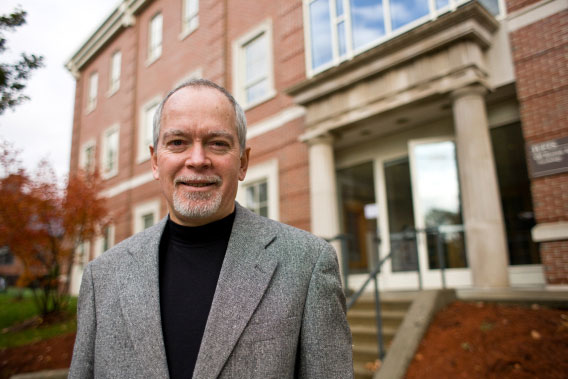The Black Box of Language
Understanding how the brain processes spoken and written language could help people with dyslexia, strokes and head injuries, not to mention those wanting to brush up on their high school French
By Helene Ragovin
Parlez-vous francais?
For Phillip Holcomb, that question represents one of his most significant, and humbling, academic challenges. As accomplished as he is in his discipline—he’s a professor of psychology and co-director of the NeuroCognition Laboratory at Tufts, with some 25 years of scholarship behind him—learning a second language as an adult has proved to be a daunting task.

“Bilingualism is a convenient way of looking at how people acquire knowledge of language,” says Phillip Holcomb. Photo: Alonso Nichols
“I struggle with French,” he admits. “It’s the hardest thing I’ve ever tried to learn—much harder, in some sense, than science was. It is humbling to be so incompetent at something that seems like it should be relatively easy.”
But Holcomb brings a different perspective to the issue: as a psychologist, he wants to know how the brain represents and processes language when we read and speak.
“We’re all proficient users of language. Why can’t we just re-map what we know using this other format?” he asks. To find out, Holcomb is leading a National Institutes of Health-funded research project on the cognitive processes associated with learning a second language as an adult. The study uses college students in the U.S. and France who are learning, respectively, French and English for the first time.
Understanding those cognitive processes has implications well beyond bilingualism, though. Holcomb hopes his work can be used to help devise strategies for children and adults with reading difficulties, such as dyslexia. It could also help stroke and head-injury victims whose language abilities are impaired, such as Iraq war veterans with concussive injuries “who will have language issues,” Holcomb says. “There is a lot of interest at government agencies for understanding language problems.”
The research could also be used to help understand psychiatric patients with thought disorders. Holcomb’s Tufts colleague, Gina Kuperberg, an associate professor of psychology who co-directs the NeuroCognition Lab, does research involving thought, language and brain activity in patients with schizophrenia at the Massachusetts General Hospital’s department of psychiatry.
What’s Spanish for “I Don’t Understand”?
One aspect of Holcomb’s work looks specifically at the task of acquiring vocabulary. “We’re focused on understanding how people learn and use words in both their native and second language,” he says.
It’s not easy work. The brain processes language, spoken and written, at lightning speed, and animal models obviously can’t be used. And, of course, the mechanics are happening deep inside a black box known as the brain. “So you need to devise clever experiments,” Holcomb says.
For example, in his work with the college students who are in the early stages of learning a foreign language, Holcomb flashes images on a computer screen and asks the students to name the pictures using the second language. At the same time, he is recording electrical activity in their brains, trying to pinpoint exactly what is happening in the brain as the subject processes the event.
It’s not a simple test—at the same moment the brain is searching for the French word for “grapefruit,” it’s also registering the hum from the heating vents, the brightness of the light in the room, if the subject’s stomach is growling and if his big toe itches.
Holcomb and his colleagues then compare brain activity when a student is recalling a word in his or her native language and when using a second language. One of the discoveries thus far, to be discussed in a paper that will appear in the Journal of Neurolinguistics in early 2009, is that as a person becomes more proficient in a second language, the brain-wave patterns start to become more similar in both languages.
Another part of the study investigates whether the cognitive process of language-learning “goes both ways”—in other words, do English speakers learning French show similar cognitive patterns to French speakers learning English? To investigate that, Holcomb and French colleagues have also been working with students at the University of Provence in Marseilles, in a parallel lab to the one Holcomb has at Tufts.
The results aren’t in yet, but it’s clear that the study has many applications. “Bilingualism,” Holcomb says, “is a convenient way of looking at how people acquire knowledge of language.”
Helene Ragovin can be reached at helene.ragovine@tufts.edu.

